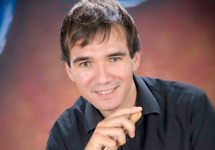NEW SYMPHONY for WIND ORCHESTRA by LUIS SERRANO ALACÓN

Commissioned by the Southeastern Conference Band Directors Association
World Premiere Thursday 17th October 2013
University of Kentucky Wind Symphony
Conductor Cody Birdwell
Singletary Center for the Arts, 7.30.pm
Alarcon’s Symphony for Wind Orchestra was commissioned by the Southeastern Conference Band Directors Association and was finished in 2012. It is published by Piles and is scored for large wind orchestra: Piccolo & 2 flutes; 2 oboes and cor anglais; Eb Clarinet, 3 Bb clarinets and bass clarinet; 2 bassoons and contra.Saxophone quartet
4 Horns; 4 trumpets in Bb, 1st doubling piccolo; 3 tenor trombones and bass; 2 euphoniums; tuba; double bass; harp; piano; timpani and 4 percussion
1 – PROLOGUE - furioso
Fortissimo octave Ds are hurled across the orchestra introducing a series of fanfares, in Gb for horns, C major for trumpets, Ab for clarinets heralded by chromatic scales, all underpinned by a menacing sliding chromatic passage. The chromatic passage appears in diminution, and becomes more important under an argument between clarinets and horns, erupting into a brief triple fortissimo coda.
11 – allegro vivace
This movement is a scherzando, a very large scale fugue or fughetto with a number of contrasting episodes, giving an overall form of a Rondo. It bustles around, carried forward by sheer high spirits rather than the strict counterpoint rules of traditional fugue. Alto saxophone states the full blown subject of eight bars, answered by oboe and clarinet, with a little two bar extension leading to an upside-down version for flutes and Eb and later xylophone. An ostinato on harp, marimba and bassoons accompanies extended solos which are drawn from the fanfares of the opening movement for alto saxophone, answered by flute.
The mood changes, poco meno mosso, but with an encouragement to rubato and a flexible approach to tempo; a more lyrical theme on oboe appears, taken up by flutes and clarinets, following the contours of the fugue subject, harmonically the language increases its chromatic quality,the little ostinato figuration gradually takes over and leads to a four bar romantic climax, molto tenuto, followed by a moving passage Semplice e tranquillo with solos for trumpet. The fugato returns in the woodwind, later bass clarinet and then tuba in inverso and augmentation, everyone joining in to boil up in an enormous crescendo. A more tragic section ensues, calmato and then accelerando but always flexible as themes from earlier are re-introduced. Finally the scherzando fugue subject returns.
111 – Adagio
The mood is again elegiac, shifting chordal passages alternate with little rhythmic motives and little rubato passages, until a passionate outburst on full orchestra brings the section to a close. A scherzando follows, a sinister Danse Macabre with a hint of Alarcon’s Spanish background in the rhythms and perhaps a brief homage to Ravel’s La Valse. From this sinister and intense mood emerges a lengthy solo for cor anglais in 2/4 joined by the whole orchestra building another huge climax; flutes, muted trumpets, harp and percussion form a link to the finale.
1V – Epilogue – come prima
The epilogue is an extended version of the Prologue, with some added passages, varied orchestrations, ending triumphantly.